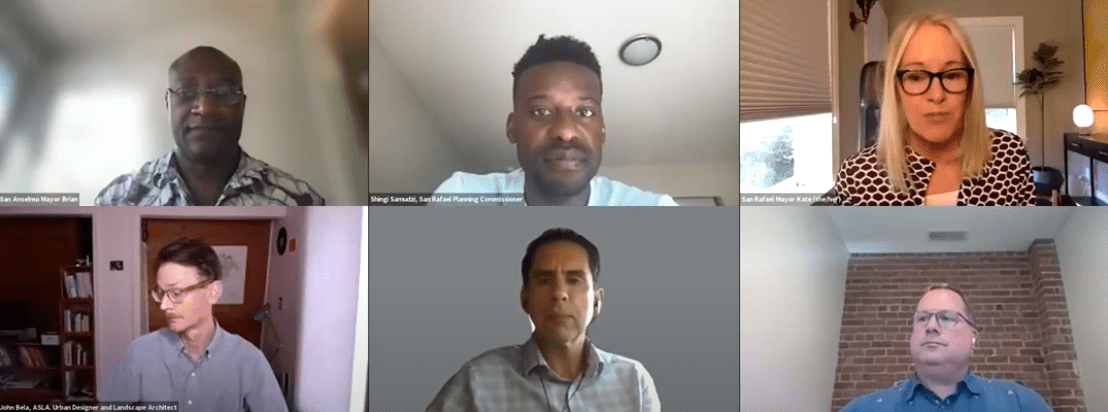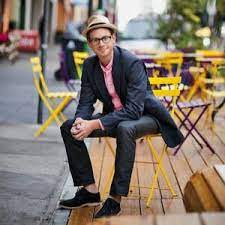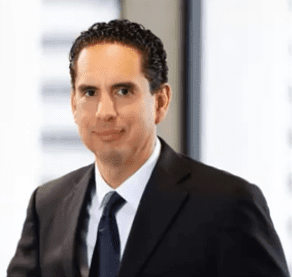To that end, an urban designer, a local restaurateur and a restaurant investor gathered in early May for a virtual symposium on the challenges ahead and adapting to the new normal after 14-plus months of earth-shaking dining and hospitality trends. The “Collaborative City-Making & Restaurant Trends” symposium, hosted by the Marin County Council of Mayors and Councilmembers, was the first in a series of discussions about how to continue to emerge from a pandemic that has taken an immeasurable toll on our communities in Marin.
“We are in recovery, but it has been very unevenly spread across various sectors of the economy,” San Anselmo Mayor Brian Colbert said at the outset. “Now is the time to lay the foundation for a Marin Economy 2.0. How do we empower and attract and retain?”
The event featured urban designer John Bela, Marc Quinones, COO of Palisades Hospitality Group, which operates the likes of Piatti Ristorante in Mill Valley, Joinery in Sausalito and Sam’s Cafe in Tiburon; and Carlos Sanchez, managing director of the Piper Sandler consumer investment banking team focusing restaurant and coffee companies.
“Infrastructure is not just roads and bridges and water and transportation systems – it’s a whole series of physical environments that support public life, civic spaces like parks and playgrounds, libraries and sidewalks, all places where people can assemble,” Bela continued, pointing to the street closures in places like Mill Valley and San Rafael that have been “a great catalyst for social interaction on our communities. These types of social spaces have been critical to enable us to encounter one another and socialize and maintain the social fabric of our communities.”
Unlike sidewalk dining, parklets are “not simply permitted cafe tables and chairs” with an annual fee associated with the use of that space. “There is a public obligation for these types of spaces,” he said.
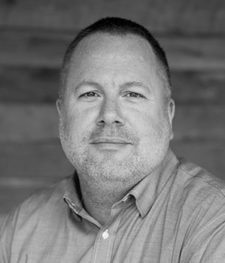 Marc Quinones
Marc Quinones
“The dining experience may take a while to seem familiar and comfortable again,” he added. “So the question is, ‘how do we make a new and changed environment feel comfortable and familiar as we start to re-emerge?” One of the COVID-19 crisis’ few benefits is that it gave restaurant owners and managers license to chart new paths, evaluate their operations from top to bottom and make changes they would have hesitated to make in normal times, he said.
Another trend is the “omni-channel experience,” the idea that restaurants, retailers and their customers embraced takeout and delivery wholeheartedly during the pandemic, and will continue to do so. Despite the need to be able to connect with customers across an “omni-channel” experience that meets them wherever they are, Sanchez suggested that restaurants look at the cost structures around delivery services with a sharp eye given the extremely high costs associated with many tech-based delivery services, in some cases with commissions as high as more than 30 percent.
Industry data indicates that “off-premise sales,” i.e. takeout and delivery, will continue to become a bigger and bigger part of the restaurant business for any type of restaurant. That trend needs to be accommodated, the trio agreed. Creating spaces to handle that demand needs to be incorporated, perhaps with dedicated spaces for both curbside takeout pickup and delivery services. “Curb management is a crucial part of this,” Bela said, noting that San Mateo uses the parking lots “behind the vibrant retail street” as dedicated short-term parking spaces for pickup and dropoff.
Parking Management
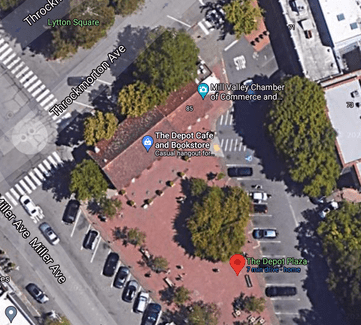
“Eyes are open in the county about this possibility – let’s take advantage of it,” he said.
Bela pointed to Donald Shoup, a professor in the Department of Urban Planning at UCLA whose 2005 book, The High Cost of Free Parking, recommends that cities should (1) charge fair market prices for on-street parking, (2) spend the revenue to benefit the metered areas, and (3) remove off-street parking requirements. A 2018 edition of the book examined the results where cities have adopted these policies and found that this trio of reforms “may be the simplest, cheapest, and fastest way to improve city life, protect the environment, and promote social justice.”
That view extends beyond parking spaces, Bela said. It also includes public gathering spaces that are not reserved solely for patrons of a specific restaurant. He cited San Anselmo’s Creek Park, which is in the midst a transformation that will create a long-term outdoor gathering and dining space open to anyone. “People are bringing food from various restaurants but also some are bringing food from home,” Bela said. Mill Valley’s Depot Plaza, with its picnic benches and chess tables, has long served a similar purpose – becoming even more popular during the pandemic.
Parklets
The Mill Valley Chamber plans to propose both temporary and permanent parklet programs in Mill Valley that would focus on the downtown streets of East Blithedale, Throckmorton, Sunnyside, Corte Madera and Miller avenues, along with Madrona Street and Miller Avenue, as the parking landscape is much more defined downtown in those areas. The Chamber proposes that no more than two parklets be approved on a single block, and the City could establish a minimum distance requirement between two parklets on the same block. For the permanent parklet program, we welcome the Council’s guidance on geographic limitations.
There are a variety of models for parklet programs. One is for a business to design and build a two-space parklet under clear design guidelines established by the city and bear the full weight of the cost associated, including fees paid to the local municipality to account for the loss of parking revenue from those spaces. There’s also the “shared space” model in which a business has a parklet but allows it to be accessible to the public outside of the business’s operating hours in exchange for a reduction or elimination of those fees.
“It’s a tricky topic,” Sanchez said. “If (the business) has to bear the full investment costs of a space, that business should benefit from that investment space. It’s all new ground here. We’re all still searching for the right balance.”
Bela said the County of Marin should take the lead to create the framework of a parklet and outdoor business use program so that each town/city could “avoid the brain damage of creating their own policy city by city. Businesses need the certainty and the public needs to know there will be design quality.”
When asked about the possibility of city-centric restaurants and retailers moving or expanding to the suburbs like Mill Valley because of the high likelihood that San Francisco office towers won’t be accommodating nearly as many workers as pre-COVID, Sanchez said, “that is the multi-billion question in the industry right now. There is no data that will tell you when people are coming back and in how many days. We’re definitely in wait and see mode.”
Bela emphasized that parklets, particularly accommodating restaurants in commercial areas, should be sure to create what he calls “social eddy spaces” that support local retailers, making sure not to block the entries of other businesses, allow for widespread outdoor retail use and seek to create the spillover effect of additional foot traffic spurred on by things like outdoor dining.
“If you’ve got 100 people walking down your street, hopefully they will stop and buy something – they need to be visible,” he said.
A Challenged Marin Economy
The dynamics and trends that the trio discussed are particularly important given the continued economic data that indicates that Marin’s recovery continues to be dragged down by employers’ difficulty in hiring. As we reported here, the national conversation about hiring challenges has turned political, with some Republicans blaming the pandemic social safety net, i.e. the federally expanded unemployment benefits, while a study by the Tobin Center for Economic Policy at Yale University indicates that it’s more complex than that.
The study found “no evidence that more generous benefits disincentivize work either at the onset of the expansion or as firms looked to return to business over time.” Money is only one part of the hiring conundrum – health concerns, expanded jobless benefits and still being needed at home are among the reasons would-be workers might be staying away, according to the New York Times.
“We have a shrinking labor force, and that is a problem,” Marin Economic Foundation Executive Direct Mike Blakeley said this week at his organization’s monthly Economic Briefing.
But it’s not just workers leery at returning to work. It’s also the fact that Marin’s population has declined for the fourth straight year, according to the latest U.S. Census data.
And in the bigger picture, Marin’s economy continues to skew heavily toward the same sectors: restaurants, hotels and personal services like hair/nail salons and fitness facilities. “We cannot continue to rely so heavily on personal service businesses. It doesn’t present a resilient economy or create those mid- to high-skilled jobs that we need to grow.”
Here’s the full recording of the symposium:


